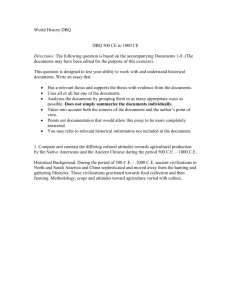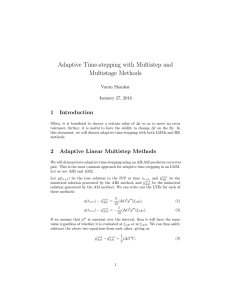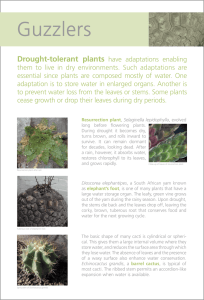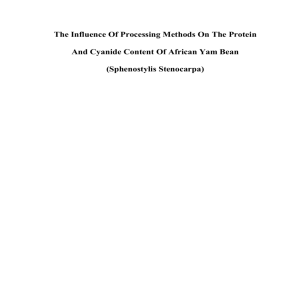Advance Journal of Food Science and Technology 3(6): 404-409, 2011
advertisement
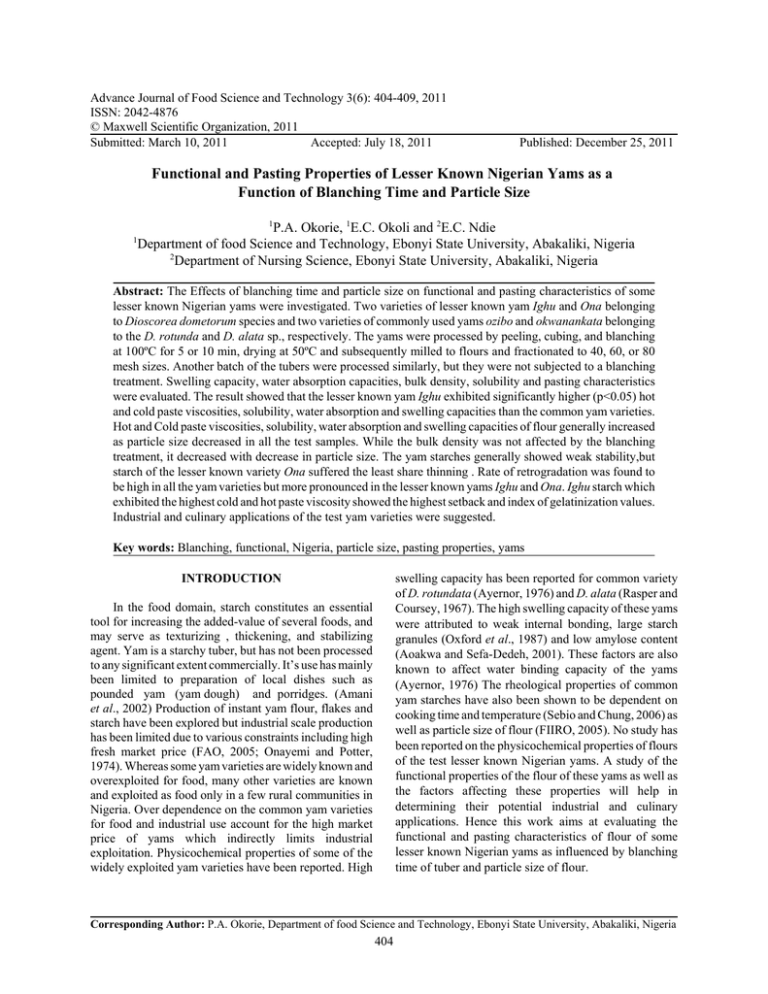
Advance Journal of Food Science and Technology 3(6): 404-409, 2011 ISSN: 2042-4876 © Maxwell Scientific Organization, 2011 Submitted: March 10, 2011 Accepted: July 18, 2011 Published: December 25, 2011 Functional and Pasting Properties of Lesser Known Nigerian Yams as a Function of Blanching Time and Particle Size 1 1 P.A. Okorie, 1E.C. Okoli and 2E.C. Ndie Department of food Science and Technology, Ebonyi State University, Abakaliki, Nigeria 2 Department of Nursing Science, Ebonyi State University, Abakaliki, Nigeria Abstract: The Effects of blanching time and particle size on functional and pasting characteristics of some lesser known Nigerian yams were investigated. Two varieties of lesser known yam Ighu and Ona belonging to Dioscorea dometorum species and two varieties of commonly used yams ozibo and okwanankata belonging to the D. rotunda and D. alata sp., respectively. The yams were processed by peeling, cubing, and blanching at 100ºC for 5 or 10 min, drying at 50ºC and subsequently milled to flours and fractionated to 40, 60, or 80 mesh sizes. Another batch of the tubers were processed similarly, but they were not subjected to a blanching treatment. Swelling capacity, water absorption capacities, bulk density, solubility and pasting characteristics were evaluated. The result showed that the lesser known yam Ighu exhibited significantly higher (p<0.05) hot and cold paste viscosities, solubility, water absorption and swelling capacities than the common yam varieties. Hot and Cold paste viscosities, solubility, water absorption and swelling capacities of flour generally increased as particle size decreased in all the test samples. While the bulk density was not affected by the blanching treatment, it decreased with decrease in particle size. The yam starches generally showed weak stability,but starch of the lesser known variety Ona suffered the least share thinning . Rate of retrogradation was found to be high in all the yam varieties but more pronounced in the lesser known yams Ighu and Ona. Ighu starch which exhibited the highest cold and hot paste viscosity showed the highest setback and index of gelatinization values. Industrial and culinary applications of the test yam varieties were suggested. Key words: Blanching, functional, Nigeria, particle size, pasting properties, yams swelling capacity has been reported for common variety of D. rotundata (Ayernor, 1976) and D. alata (Rasper and Coursey, 1967). The high swelling capacity of these yams were attributed to weak internal bonding, large starch granules (Oxford et al., 1987) and low amylose content (Aoakwa and Sefa-Dedeh, 2001). These factors are also known to affect water binding capacity of the yams (Ayernor, 1976) The rheological properties of common yam starches have also been shown to be dependent on cooking time and temperature (Sebio and Chung, 2006) as well as particle size of flour (FIIRO, 2005). No study has been reported on the physicochemical properties of flours of the test lesser known Nigerian yams. A study of the functional properties of the flour of these yams as well as the factors affecting these properties will help in determining their potential industrial and culinary applications. Hence this work aims at evaluating the functional and pasting characteristics of flour of some lesser known Nigerian yams as influenced by blanching time of tuber and particle size of flour. INTRODUCTION In the food domain, starch constitutes an essential tool for increasing the added-value of several foods, and may serve as texturizing , thickening, and stabilizing agent. Yam is a starchy tuber, but has not been processed to any significant extent commercially. It’s use has mainly been limited to preparation of local dishes such as pounded yam (yam dough) and porridges. (Amani et al., 2002) Production of instant yam flour, flakes and starch have been explored but industrial scale production has been limited due to various constraints including high fresh market price (FAO, 2005; Onayemi and Potter, 1974). Whereas some yam varieties are widely known and overexploited for food, many other varieties are known and exploited as food only in a few rural communities in Nigeria. Over dependence on the common yam varieties for food and industrial use account for the high market price of yams which indirectly limits industrial exploitation. Physicochemical properties of some of the widely exploited yam varieties have been reported. High Corresponding Author: P.A. Okorie, Department of food Science and Technology, Ebonyi State University, Abakaliki, Nigeria 404 Adv. J. Food Sci. Technol., 3(6): 404-409, 2011 Table 1: Amylose and amylopectin content (%) of flours from different yam varieties Amylose/amy Variety of yam Amylose Amylopectin Lopectin ratio Ozibo 20.95a 79.05b 0.265 Okwanankata 22.64a 77.36b 0.290 Ighu 20.80a 79.20b 0.262 Ona 21.41a 78.59b 0.272 Values are means of three replicate. Values with the same letter (a or b) are not significantly different at (p #0.05). MATERIALS AND METHODS The four varieties of Nigerian yams studied are; "Ozibo" a variety of D. rotunda, Ona and "Ighu" are varieties of D. dometorum and "Okwanankata a variety of D. alata. The "Ozibo", "Okwanankata" and "Ona" were purchased from a village market in Izzi Ebonyi State, South East of Nigeria. Ighu was purchased from OyaAgu, Udi in Enugu State. South East Nigeria (The location of purchase was based on availability). The ozibo variety is the popular white yam variety. Table 2: Variation of yam starch solubility with blanching time Yam variety Unblanched Blanching time 5 m 10 m Ozibo 31.63a 33.77b 38.50c Okwanankata 29.26a 32.33b 35.42d Ighu 30.60a 41.50a 48.10a Ona 30.70a 39.00a 45.30b Along the same rows values followed by the same letters are not significantly different (p>00.05) Production of yam flour: A set of unblanched yam flour was prepared from each of the four varieties of yams. The yam tubers were peeled, washed, diced and dried in a laboratory electric oven (Ambassador) at 45-50ºC for 48 h. The dried yam was milled in an attrition mill, The flour from the mill was fractionated to 40, 60 and 80 mesh sizes using the method described by Okaka et al. (1997). The samples were then stored in a freezer compartment. To prepare blanched yam flour, The yam tubers were peeled, washed, diced and blanched. The first batch was blanched at 100ºC for 5 min, while the second was blanched 100ºC for 10 min. The samples were then dried at 45-50ºC for 48 h in an electric oven (Ambassador), milled in an attribution mill and the flour obtained were subsequently fractionated as described earlier and stored in a freezer compartment. Evaluation of pasting properties: Rapid ViscoAnalyzer was used to evaluate the pasting properties of the yams. The instrument was used to access the pasting temperature, peak viscosity, stability, cold paste viscosity, set back and index of gelatinization RESULTS AND DISCUSSION Amylose and amylopectin: The Amylose and Amylopectin contents of the yam varieties are presented in Table 1. The results showed that the amylose fraction in the yam varieties ranges from 20.8-22.64%. Flour derived from Okwanankata had the highest amylose fraction (22.64%) while the Ighu had the least (20.8%). Statistically there was no significant difference(p$0.05) in the amylose and amylopectin contents of the yam varieties. Determination of amylose and amylopectin content: The method described by Williams et al. (1970) was used to determine the amylose and amylopectin contents. The concentrations of the amylose in the samples were determined by reference to amylose standard curve. The amylopectin content were obtained by subtracting the amount of amylose from the total amount of starch and the values were expressed as percentage of starch content. Solubility: Table 2 shows the solubility of the starch of the yam varieties as affected by the blanching time .The results showed that solubility of the starches of the test yam varieties were not significantly different (p>0.05)in un blanched samples. Solubilities of the samples were significantly affected by blanching time at 100ºC. The flours from unblanched samples had an average solubility value of (30.6%) which was significantly lower (p#0.05) than solubility of yam starch blanched for 5 min (36.6%). Yam samples blanched for 10 min on the average yielded starch which was more soluble (41.8%) than the 5 min treatment by 14.1%. In general, the ighu variety was most soluble at both blanching times. Particle size significantly affected the solubility of the yam starches studied (Table 3). Solubility was lowest in flour samples of 40 mesh particle size and highest in samples with 80 mesh size. 60 mesh size samples had intermediate solubility relative to other samples. This trend was observed in both blanched and un blanched samples. Determination of solubility: The solubility of the flour samples at 70ºC were determined by the method described by leach et al. (1959). Determination of swelling capacity: The swelling capacity of the flour samples were determine using the method described by Onayemi and Potter (1974). Determination of water absorption capacity: The water absorption capacity of the flour samples were determined as described by Okoli (1998). Determination of bulk density: The bulk density was determined using the method described by Mao et al. (1965). 405 Adv. J. Food Sci. Technol., 3(6): 404-409, 2011 Table 3: Effect of particles size on solubility of yam starch Unblanched Blanched --------------------------------------------------------------------------------------------------------------------------------------Yam variety 40 Mesh 60 Mesh 80 Mesh 40 Mesh 60 Mesh 80 Mesh Ozibo 28.2a 30.4b 36.3c 32a 34.0c 34.6f Okwanankata 27.9a 29.2b 30.7c 36b 33.0c 34.0f Ighu 28.0a 30.0b 34.0c 38b 41.2d 45.3g Ona 28.4a 31.0b 32.8c 36b 39.4d 42.0h Along the same rows values followed by the same letters are not significantly different (p >0.05) Table 4: Effect of blanching on bulky density of yam flour Blanching time (m) ----------------------------------------Yam variety Unblanched 5 min 10 min Ozibo 0.52a 0.53a 0.54a Okwanankata 0.46c 0.48c 0.49c Ighu 0.41a 0.42a 0.43a Ona 0.38d 0.35d 0.40d Along the same rows values are not significantly different(p>0.05) highest bulk density (0.53 g/mL) followed by Okwankata (0.49 g/mL) and Ighu (0.425 g/mL). Ona flour was the least bulky with an average value of 0.39 g/mL. The bulk density showed consistent decline with decrease in particle size (Table 5). This is in agreement with the report of Okaka et al. (1997) which suggested that bulk density of flour is not affected by factors such as blanching time and temperature, but is affected by factors such as particle size. The significantly low bulk density of Ona will make this variety usefully in food formulations where low bulk is desired such as in baby foods. Blanching for 5 and 10 min, respectively produced 6.7 and 21% increase in solubility in Ozibo. 10.4 and 21% increase in Okwanankata, 35.4 and 56.8% increase Ighu and 27 and 47.5% increase in Ona. These results suggest that increase in blanching time produced more significant increase in solubility in Ighu and Ona than in Ozibo and Okwanakata. In all cases the Ighu and Ona varieties showed greater response to increase in solubility with decrease in particle size. However, it is worthy to note that the increase in solubility observed with decreases in flour particle size was more pronounced in unbalanced samples . The range of applications of flour as food ingredients is dependent on their solubility since their interactions with water determines to what extent they can impact their desired functionality. The present investigation show that the starch of the lesser known yam varieties especially the Ighu and Ona are highly soluble when blanched at 1000C. These varieties of yam will find good applications in food system where solubility of starch is needed. Swelling capacity: Swelling capacities (%) of the flours from the test yam varieties yam are shown on Table 6 and 7. The results showed that the test flours showed moderate swelling power, and that particle size of the flour affect the swelling capacity. (Table 6 and 7) Swelling capacity was generally highest in flour with particle size of 80 mesh and decreased as the particle size increased to 40 mesh. Ozibo for instant in unbalanced form had the swelling capacity of 86, 87 and 88% for 40, 60 and 80 mesh particle size respectively showing 2.2% increase in swelling capacity as the particle size decreased from 40 to 80 mesh. This trend was similar in the other 3 varieties. Blanching given to tuber affected the swelling capacity of the yam flours. In unblanched samples, Ighu had the highest mean swelling capacity of (95%) while Ozibo had the least (87%) Okwanankata and Ona had the swelling capacity 90 and 93.3%, respectively. Blanching of the tuber for ten minutes increased the swelling capacity of Ozibo flour by 10% and that of Okwanakata, Ighu and Ona by 6.2, 4.2 and 5.2%, respectively. The flour from lesser known vars Ighu and Ona had significantly higher (p<0.05) swelling power than the Bulk density (g/mL): The bulk densities of the yam flours are presented in Table 4 and 5. The results showed that blanching time had no effect on bulk density of flour. Bulk density was however significantly (p#0.05) affected by the particle size of the flour as well as the variety of yam. On the average, the flour derived from Ozibo has the Table 5: Effect of partizle size on bulk density (g/mg) of yam Unblanched Blanched ----------------------------------------------------------------------------------------------------------------------------------------------Yam variety 40 mesh 60 mesh 80 mesh 40 mesh 60 mesh 80 mesh Ozibo 0.53a 0.52e 0.50i 0.57n 0.53s 0.51t Okwanankata 0.49b 0.46f 0.44j 0.49p 0.47v 0.47w Ighu 0.44c 0.42g 0.39m 0.44q 0.43x 0.42u Ona 0.40d 0.39h 40 mesh 0.41r 0.40y 0.39k Along the same rows values followed by the same letter are not significantly different (p>0.05) 406 Adv. J. Food Sci. Technol., 3(6): 404-409, 2011 Table 6: Variation in swelling capacity (%) of yam Unblanched particle size Blanched particle size ----------------------------------------------------------------------------------------------------------------------------------Yam variety 40 mesh 60 mesh 80 mesh 40 mesh 60 mesh 80 mesh Ozibo 86.0a 87d 88h 92.2e 95.2s 97.9u Okwanankata 89.4b 90e 91k 89.4f 94.4x 97.6u Ighu 93.0c 94f 98l 96.4v 97.6j 99.3y Ona 90.0c 93g 97m 94.0t 97.2j 99.0y Along the same rows values followed by the same letter are not significantly different (p>0.05) Table 7: Variation in swelling capacity (%) of yam flour with blanching time Blanched ---------------------------------------Yam variety Unblanched 5m 10 m Ozibo 87.0a 95.1r 96.2s Okwanankata 90.0b 93.9d 95.6g Ighu 95.0c 97.8h 99.0p Ona 93.3d 96.7q 98.2m Along the same rows values followed by the same letter are not significantly different (p>0.05) Water absorption capacity: Variation in water absorption capacities of the yam varieties with blanching time is presented in Table 8. The data show that water absorption capacities of the yams vary significantly with blanching time .In the unblanched samples, Ighu had the highest water absorption capacity(131%)while Okwanankata had the least (127.7%) Ozib 29.7% and 1307% water absorption capacities, respectively. In all the varieties, blanching increased the water absorption capacity. Blanching at 100ºC for 10 min increased water absorption capacity by 4, 3.4, 3.8 and 5.4%, in Ozibo, Okwanankata, Ighu and Ona , respectively. These results showed that Ona responded more than other yam varieties to increase in blanching time with respect to water absorption capacity. While Okwanankata responded least to the influence of blanching time. The results also showed that water absorption increased with decrease in particle size of the sample (Table 9). For Ozibo, it decreased from 136 to 127.7% as the particle size increased from 80 to 40 mesh, showing a percentage decrease of 8.3%. For Okwanankata the water absorption decreased from 131.7% in 80 mesh to 127% in 40 mesh showing 4.7% decrease. Water absorption capacity of Ighu decreased from 140 to 129% when the particle size of flour is varied from 80 to 40 mesh. This amounts to 7.9% decrease in water absorption capacity. In Ona, the water absorption capacity decreased from 137 to 131% with decrease of particle size from 80 to 40 mesh. This amount to 6% decrease. These results suggest that Ighu responded more to particle size change than other yam varieties with respect to water absorption capacity. Water absorption capacity may be an advantage in applications of the lesser known yam flours in such food systems as baby food formulations ,fufu production and bread making where increase water absorption of the flour will increase product yield (Okoli, 1998). Table 8: Effect of blanching on water absorption capacity of yam Blanched -------------------------------------Yam variety Unblanched 5m 10 m Ozibo 127.9a 131.7b 135c Okwanankate 127.7a 129.3b 132k Ighu 131.0b 136.0e 136d Ona 130.7b 134.0d 138h Along the same rows values followed by the same letter are not significantly different (p>0.05) Table 9: Variation in water absorption capecity with particle size of yam flour Particle Size ------------------------------------------------------------Yam variety 40 mesh 60 mesh 80 mesh Ozibo 127.7a 132.7r 136g Okwanankate 127.0a 130.3e 132t Ighu 129.0b 134.0f 138h Along the same rows values followed by the same letter are not significantly different (p>0.05) Table 10: Variation in peak viscosity (RVA) with blanching time Blanched ------------------------------------Yam variety Unblanched 5 m 10 m Ozibo 154.0b 166e 173.0f Okwanankate 117.0d 129s 145.0g Ighu 251.0a 254x 291.0k Ona 139.6c 154h 175.6j Along the same rows values followed by the same letter are not significantly different (p>0.05) Pasting characteristic: Peak viscosity of flours derived from blanched and un-blanched tubers is shown in Table 10. The results showed that in un-blanched samples, Ighu had the highest peak viscosity (Average of 251 RVA) followed by Ozibo (154RVA) and Ona (139.6 RVA) while Okwanankata had the least (117RVA). In all cases, blanching increased the peak viscosity of the yam flour. Blanching the yam at 100ºC for 5 min increased the peak viscosity by 19 RVA, 28RVA, 40RVA and 36 RVA commonly used yam vars. Ozibo and Okwanankata. Moderate to high swelling power enhances the functionality of flours in such food system like breakfast cereals, baby foods and fufu. (Okoli, 1998). These results indicate that flour and starch derived from Ighu and Ona could be useful in breakfast cereals, baby foods and other food formulations where high swelling capacity is required. 407 Adv. J. Food Sci. Technol., 3(6): 404-409, 2011 Table 11: Variation in pasting characteristics of yam flour with particle size Yam Viscosity after 15 variety Particle size Peak viscosity minutes heating at peak Final viscosity Ozibo 40 mesh 137 122 153 60 mesh 165 153 168 80 mesh 182.2 171 190 Okwanankata 40 mesh 108.9 97.1 125 60 mesh 127 96 140 80 mesh 165 99 175 Ighu 40 mesh 192 140 260 60 mesh 300 127.5 360 80 mesh 314 110 370 Ona 40 mesh 147 140 166 60 mesh 150 145 168 80 mesh 173.2 161 189 * value are Means of three replications in Ozibo, Ighu and Ona respectively. Increasing the blanching time to 10 min increased the viscosity more. The peak viscosity of the flour increased as the particle size of flour decreased irrespective of the variety of yam (Table 11). The viscosity after 15 min heating at the peak as well as final Viscosity increased with decrease in the particle size. Starch Stability, which defines the change in viscosity of the starch paste after heating and stirring at maximum temperature for 15 min measures the ability of the swollen starch granules to resist deformation and bursting during a constant heating and stirring process. These results (Table 11) show that the yam starches have very low stability (weak) and the starch paste breaks down rapidly when subjected to intense sharing force. The ighu starch paste which exhibited the highest Peak Viscosity, swelling and water absorption capacity was the most unstable whereas the ona starch paste which had moderate peakviscosity, water absorption and swelling indices was the most stable. Starch stability is important in determining the application of starch in many food systems. Ona starch with moderate swelling capacity and relatively higher starch stability will be useful as filler in meat canning industry on account of low shear thinning characteristics. The Final viscosity, Setback value as well as the Index of gelatinization values measure the rate of recrystallization of gelatinized starch (retro gradation) .In this study, the final viscosity of the test yam pastes were found to increase with blanching time and decrease in particle size irrespective of the variety (Table 11). Ighu on the average recorded the highest set back values and index of gelatinization while Ozibo recorded the least set back and index of gelatinization at the condition of the studied. Okwanankata and Ona gave moderate values (Table 11). The low cold paste viscosities, setback and index of gelatinization values of the test yam varieties may have implications on their application in many industrial and traditional food systems. In the use of yams for the Set back value 16 3 8 16 13 10 60 60 56 19 18 16 Index of gelatinization 31 15 19 28 44 71 120 240 209 26 23 28 Starch stability 12 11 11.8 31 66 52 172.5 204 7 5 12 production of instant pounded yam flour, where a gel of high rigidity is desired from a pre-gelatinized yam flour, the lesser known yam , Ighu , will produce a better paste than the commonly used yam, Ozibo, on account of high setback and index of gelatinization values. Ozibo and Okwanankata on account of their low retro- gradation rate may be useful in the production of the traditional pounded yam where the gelatinized starch is further texturized by a pounding process. They may also find good use in wheat/yam composite flour bread making where they can contribute to low bread stalling. CONCLUSION AND RECOMMENDATION The results of this study show that the lesser known yams Ona and Ighu contain amylase and amylopectins in ratios similar to that in common varieties Ozibo and Okwanakata . However, the lesser known varieties exhibit significantly higher starch solubility, water absorption and swelling capacities than the regularly used yams. Flours derived from the lesser known varieties (Ona and Ighu) also exhibit lower bulk density that the better known yams (Ozibo and Okwanakata). Water absorption and swelling capacity of tested yam flours generally increased with decrease in particle size and increase in blanching time. Hot and cold paste viscosities as well as Viscosity after 15 min heating followed the trend already highlighted for starch solubility, water absorption and swelling capacity, but Ona starch paste suffer the least shear thinning, and was the most stable thus suggesting that this lesser known yam starch may be useful as a filler or binder in meat canning and other industries . In addition, the low bulk density exhibited by Ona flour may also make it useful in baby food production. On the other hand, the flours derived from blanched Ighu (lesser known yam) which showed significantly higher hot and cold paste viscosities as well as high set back and index of gelatinization values will function optimally in the production of instant pounded yam flour. 408 Adv. J. Food Sci. Technol., 3(6): 404-409, 2011 Okaka, J.C., G.N. Anosike and A.N.C. Okaka, 1997. Effect of particle size profile of sun dried and ovendried cowpea flours on their physical and functional characteristics on model systems. J. Sci. Tech., pp: 65-74. Okoli, E.C., 1998. Effect of Grammar irradiation on Biochemical, Malting and keeping Quality of sorghum grain. Ph.D. Thesis, Obafemi Awolowo University, Ile-Ife, pp: 37. Oxford, P.D., R.V. Corrol, M.J. Miles and V.J. Morris, 1987. The effect of concentration and botanical sources on tht gelation and retrogradadtion of starch. J. Sci. Food Agric., 41: 180-182. Onayemi, O. and N.N. Potter, 1974. Preparations and properties of drum dried yam (D. rotundata Poir) flakes. J. Food Sci., 39: 559-562. Rasper, V. and D.G. Coursey, 1967. Properties of starch of West African Yam. J. Sci. Food Ag., 2: 42-44. Sebio, L. and Y.K. Chung, 2006. Effect of Selecte Parameters in the Extrusion of yam flour (D. rotundata) on Physicochemical Properties Extrudates. Retrieved from: www.pubmad.gov. Williams, P.C., R.D. Kuzina and I.A. Iflynka, 1970. rapid calometricprocedure for estimating amylose content of starches and flour. Cereal Chem., 47: 411-420. REFERENCES Amani, N.G., D. Dufour, C. Mestress and A. Kamenno, 2002. Resistance to Technological Stress of Yam Starch Gells. Food Africa internet, Retrieved from: http www.foodafrica.NutrL.org. Aoakwa, E.O. and S. Sefa-Dedeh, 2001. Properties and changes in the pasting characteristics of trifoliate yam (D. dumatorium pax) after harvest. Food Chem., 77: 203-208. Ayernor, G.S., 1976. Particulate properties and rheology of pre-gelled yam (D. rotundata). Prod. J. Food Sci., 41: 180-182. FAO, 2005. Root, Tuber, Plantation and Banana in Human Nutrition. Retrieved from: www.fao.orgjdata. FIIRO, 2005. Instant Pounded Yam Flour Technology. Retrieved from: www.fiiro.gov.ng/instantpounded yam.htm. Leach, H.W., L.D. Mcowen and T.T. Schoch, 1959. Structure of the starch granule, swelling and solubility patterns of various starch. Cereal Chem. Miniesata, 36: 385-391. Mao, G.H., J.P. Blocher and D. Adderson Land Smih, 1965. Cyanogenesis of sorghum Vulgare, II. An improved method for isolation of dhurrin. Phytochem., 4: 297-303. 409
